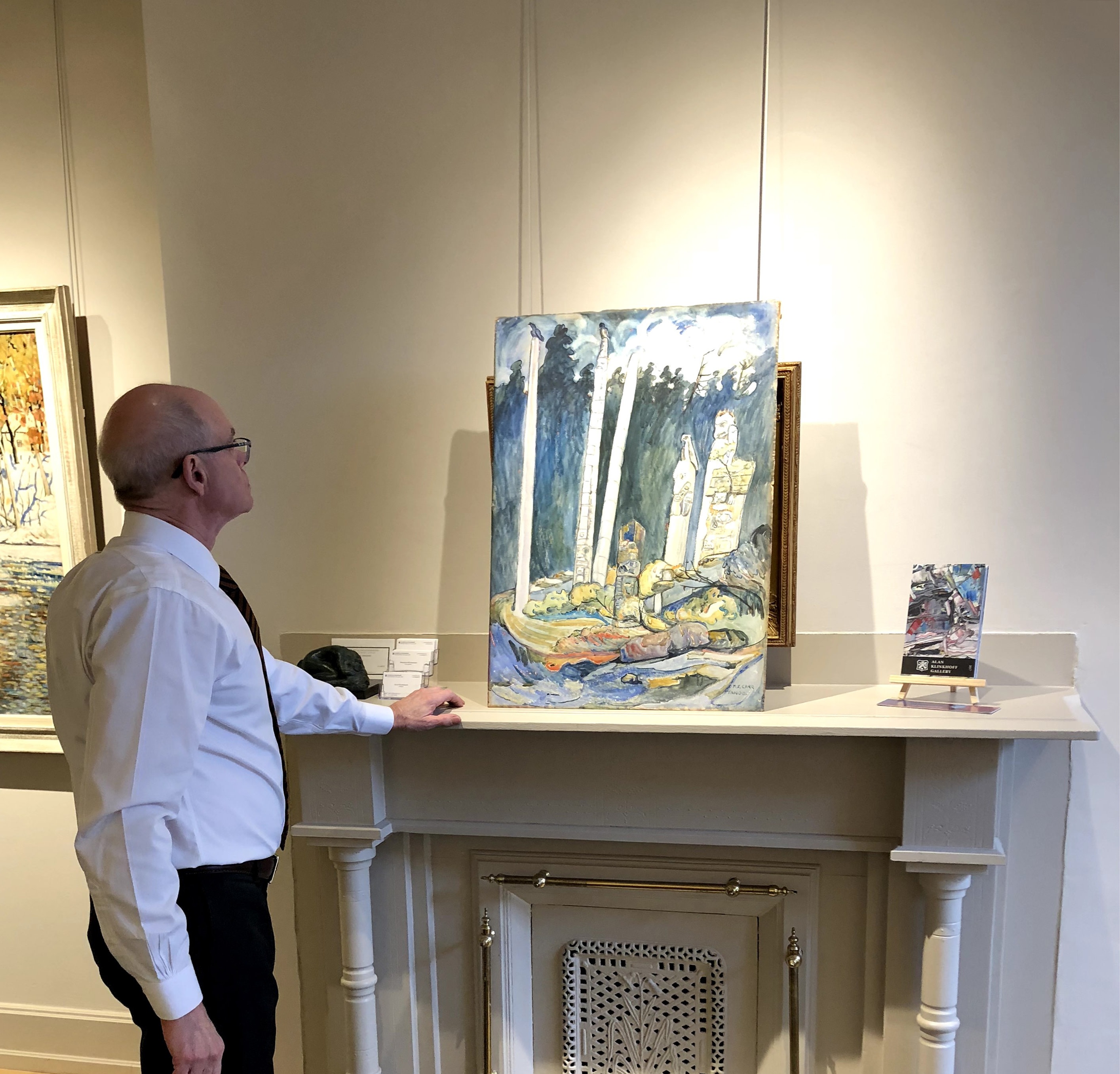La Nature dans l'Oeuvre d'Emily Carr
As difficult as it is to define what it is to be Canadian, it may be even harder to define what constitutes Canadian art. Or is it? More than in any other culture, Canadian artists have drawn inspiration from the rugged nature that surrounds them. This demanded a pictorial treatment of a very different kind, and which ultimately gave birth to a visual lexicon like no other.
Landscape, in the words of Lawren Harris of the Group of Seven, is an essential element of the spirit of Canada. Cut off from Europe and thus the influence of the various art movements sweeping through that continent, the Canadian artists were true pioneers, discovering and establishing their own vision of art, and in the process, of themselves.
Unlike European artists, the Canadian creators had little in the way of shared experience, common points of departure, or tested media techniques. With eyes and minds wide open, they forged a new set of visual tools, laying a foundation for so many generations to come. Clearing the path, as it were.

Emily Carr's Totem's Tanoo (1912) at Galerie Alan Klinkhoff
No one, perhaps, embodied that pioneering spirit more than Emily Carr. Her solitary and eccentric existence is the stuff of legends. To reduce her to a symbol would be to do a disservice to a great artist, and a fiercely independent being, whose work transcended time, gender and national image making.
And yet, like the painters of the Group of Seven, Carr has left a legacy of great national, as well as artistic value. The subject of her oeuvre was uniquely Canadian as the nature that inspired and sustained her. A great solitary wind blows through that landscape, and loneliness marked Emily Carr's life. It would be facile to say it found its outlet in her art, painting and writing, for it is also true that it was a source of suffering.
Like possibly most of us, she was the victim of her own character, but unlike many, she faced her demons with disarming courage and humour. "I was born during a December storm. Contrary from the start. The wind blew, the trees moaned. The storm in my life has never quite lulled. I've been tossing and wrestling with it ever since," Emily Carr wrote in her diaries. She was born on December 13, 1871 in Victoria, BC, and raised in a comfortable, albeit strict, environment. A rebel and free spirit, she found little in common with her 'girlie' sisters and sickly brother, and throughout her entire life she refused to conform to the Victorian mores that both her family and society attempted to impose on her.
She drew from an early age. Her first drawing, tellingly, was of the family dog, her attraction to and affinity with nature manifesting itself from the beginning.
Her artistic training was hardly instrumental in the development of her style, at least not until she went to Paris in 1910 and fell under the spell of Post-Impressionism.
However, long before artistic expression became the focus of her creative endeavours, Carr became enchanted with, and forever devoted to, the magnificent art and rich culture of the West Coast First Nations people.
Her fascination began with a visit in 1898 to Ucluelet, an Indian Reserve on Vancouver Island. This visit planted the seed that would blossom into a lifelong dedication to what was then a disappearing art form. While there, Carr fell in love with the mystery and monumentality of totem poles, and embarked on an ambitious project of trying to document them before the encroachment of commercialism, which she sensed would spell the end of a rich and unique form of expression.
Carr sketched in situ, inhaling as it were the totem's presence in it's original setting, its "own actual reality," profoundly aware of its cultural significance.
But there was more to Carr's preoccupation with First Nations culture. An often misunderstood and rebellious soul, she found much in common with the First Nations people, "a sympathy and sincerity I longed for." Her happiest times would always be during her visits to the Indian fishing villages, where she was nicknamed "Klee Wych" or "The Laughing One" by the locals. (The moniker served as the title of her first book, which won her the Governor General's Award for Literature in 1941).
When not painting, Carr made a living teaching, and briefly, as a cartoonist. In 1910 she left to study art in France. Under the auspices of such teachers as Frances Hodgkins, she found validation for her beloved subject matter; her totem poles painted during that period were beautifully nuanced by a Post-Impressionistic influence. For the first time, perhaps, Carr confirmed her vision of totem poles as works of art, not curiosities.
She returned to Vancouver and prepared an exhibition of some 200 works, in an attempt to draw attention to a "dying culture." Whether due to the difficult economic times, or lack of appreciation for Carr's artistic vision (some critics found her paintings too colourful), the collection was not purchased as the artist had hoped. Disappointed and disillusioned, she gave up painting and sought another form of income. With inheritance money she purchased a small house with rentable rooms and reluctantly transformed herself from an artist to a landlady.
Calling her new home a "House of all Sorts," Carr was clearly unhappy in her new role. She often found refuge in the attic, where she painted two enormous eagles with wings that spanned the ceiling. There, under "the strong Indian symbols," that made "strong talk for me, as my Indian friends would say," Carr waited for fate to free her.
The breakthrough came in 1927, with an exhibition of Canadian West Coast art organized by Eric Brown, director of the National Gallery, and folklorist, Marius Barbeau. In a stroke of genius, they invited Emily Carr to participate, and her works dominated the entire show.
It was at this time, in Ottawa, that she first met the Group of Seven, and that encounter was like an explosion, ending the isolation and shattering forever the stagnation that shackled her. She found a particular, almost spiritual, affinity with Lawren Harris, and was moved to poetry by the power of his art. "Something has spoken to the very soul of me," she wrote, inspired by Harris's "awe-filled spaces."
Thus fortified by the support and recognition she received from her artistic counterparts—for the first time perhaps—Carr embarked on the second phase of painting Native art. Although some of her work began to resemble that of the Group of Seven, this was not her aim. Rather, she wanted to depict the West Coast with the same ardour that imbued the images of Northern Ontario painted by her male colleagues.
"I was not ready for abstraction. I clung to earth and her dear shapes, her destiny, her herbage, her juice. I wanted her volume, and I wanted to hear her throb. I was tremendously interested in Lawren Harris's abstraction ideas, but I was not yet willing to accept them for myself." Yes, she wanted to be one of them, but labels - that of a feminist, among others - did not stick to Emily Carr. Hers was a higher goal. Creatively, however, she had reached an impasse. Painting totem poles became, in the words of her mentor Harris, like "making art out of art" and she followed his advice by resolving to paint nature.
True to her indomitable spirit, Carr purchased a small caravan, which she whimsically named "The Elephant," and equipped it with paints and brushes. Surrounded by her menagerie of dogs, cats, birds, and her beloved Javanese monkey, Woo, she ventured into the woods, emerging, as if after an epiphany, with paintings of such beauty and intensity as to take one's breath away. Carr's skies swirl and undulate, the colour planes fold and touch, all is harmonious, all is in motion, all is life, and the viewer is left in awe, just as, perhaps, she stood in awe in front of the paintings by Harris and Jackson, Lismer and Varley.
Life interjected again, and slowed by a severe heart ailment, Carr curtailed her painting escapades, devoting more and more time to writing. It is an interesting phenomenon in the lives of many artists—writing becomes an extension of the brush, another voice that emerges to carry on the message.
It is almost ironic that Emily Carr gained public recognition first through her writing, and more specifically, through the broadcasting on CBC radio of excerpts from her award-winning book, Klee Wych, in 1941. It is not surprising, however. Carr's writing is witty and laconic. She is simply talking, her sentences light and meaningful, the humour forever present.
It would not be right to end on that note, however. For as accomplished and important as Carr's writings are, they pale in comparison with her visual production, with the overwhelming intensity of her paintings. Impossible to categorize, she was inspired by Cubism, Fauvism, as well as Post-Impressionism, and she will always be linked to the Group of Seven. However, Emily Carr was first and foremost true to herself. She painted more intuitively than any other artist of her time, unobstructed, free from the chatter, the proverbial "madding crowd." Perhaps lonely, but not quite alone. The totem poles in her works stand as sentinels, symbolic of so much, painted with an intuitive understanding of their vocabulary, which, after all, was alien to her. Despite her love and dedication to First Nations culture, Carr was hardly an anthropologist. Hers was a soul connection, and the catalyst was nature, which she sensed with a shared reverence and respect. This was her land, and she listened to its voice, translating it into canvases that ultimately form one grand tableau, a paean to the beauty of Nature.
A new monument to mark the grave of Emily Carr was unveiled at Victoria's Ross Bay Cemetery in March, and the inscription on the granite marker is taken from Carr's journals: "Dear Mother Earth! I think I have always specially belonged to you. I have loved from babyhood to roll upon you, to lie with my face pressed right down onto you in my sorrows. I love the look of you and the smell of you and the feel of you. When I die, I should like to be in you, uncoffined, unshrouded, the petals of flowers against my flesh and you covering me up."
© Copyright Dorota Kozinska and Galerie Walter Klinkhoff Inc.





Add a comment